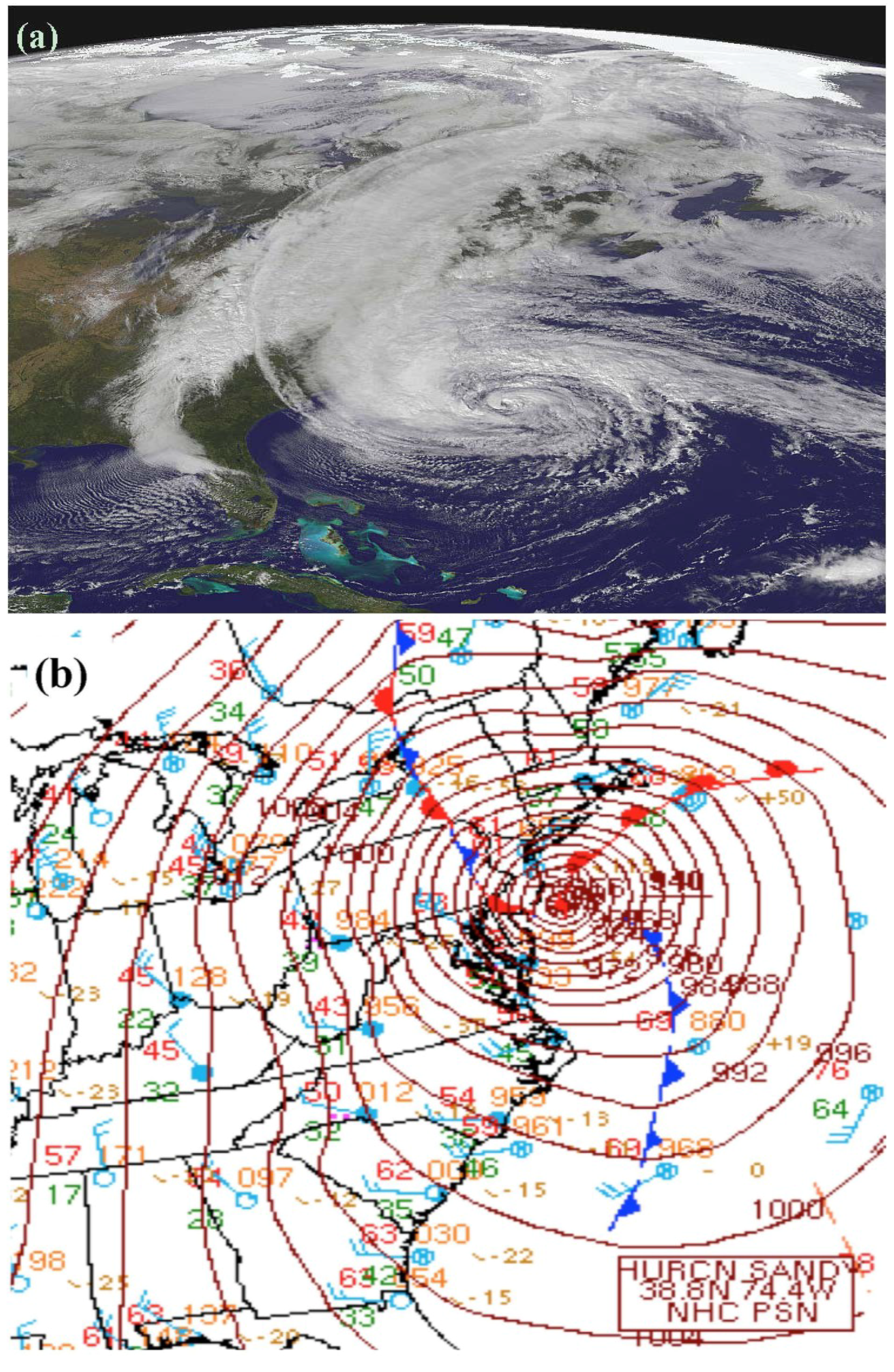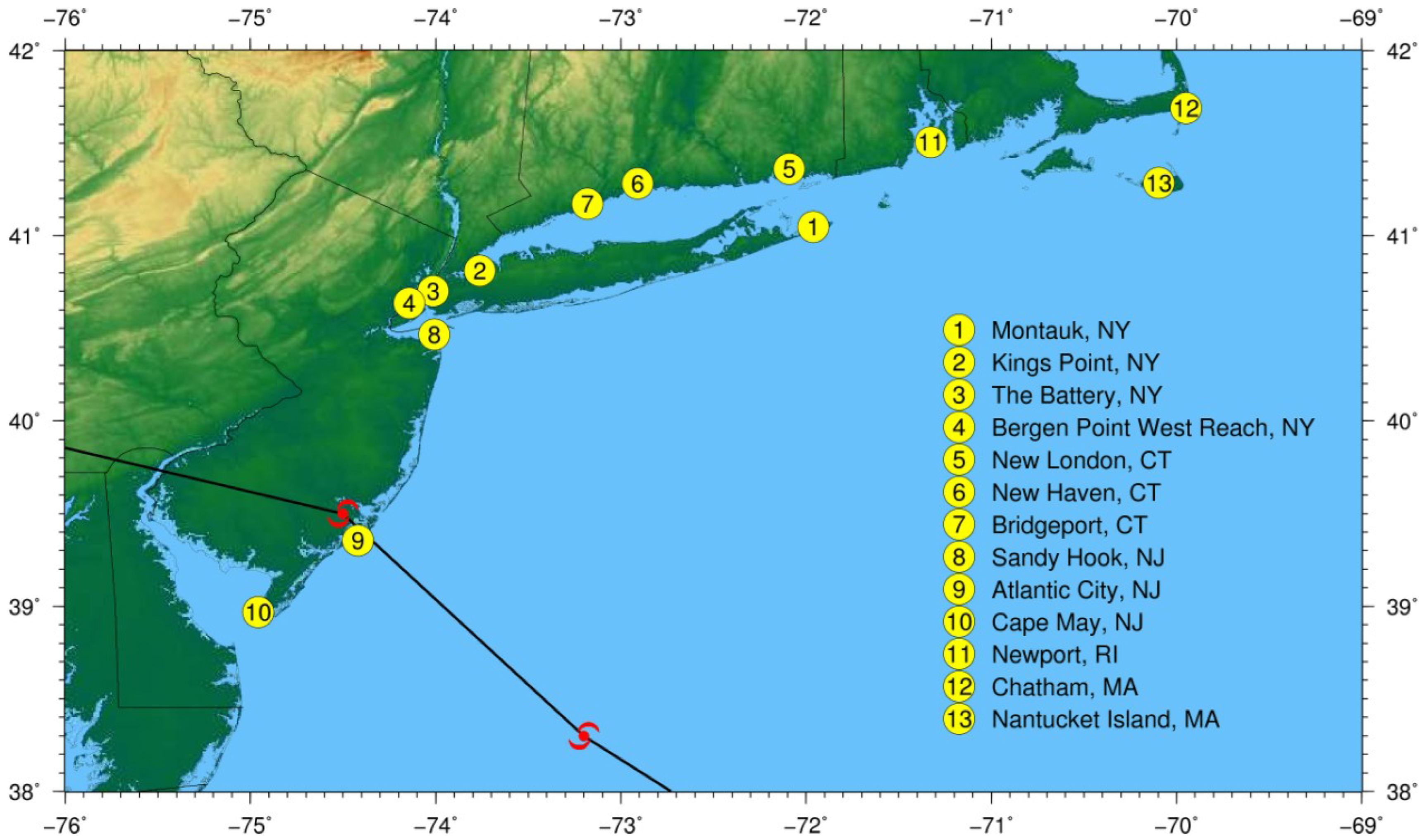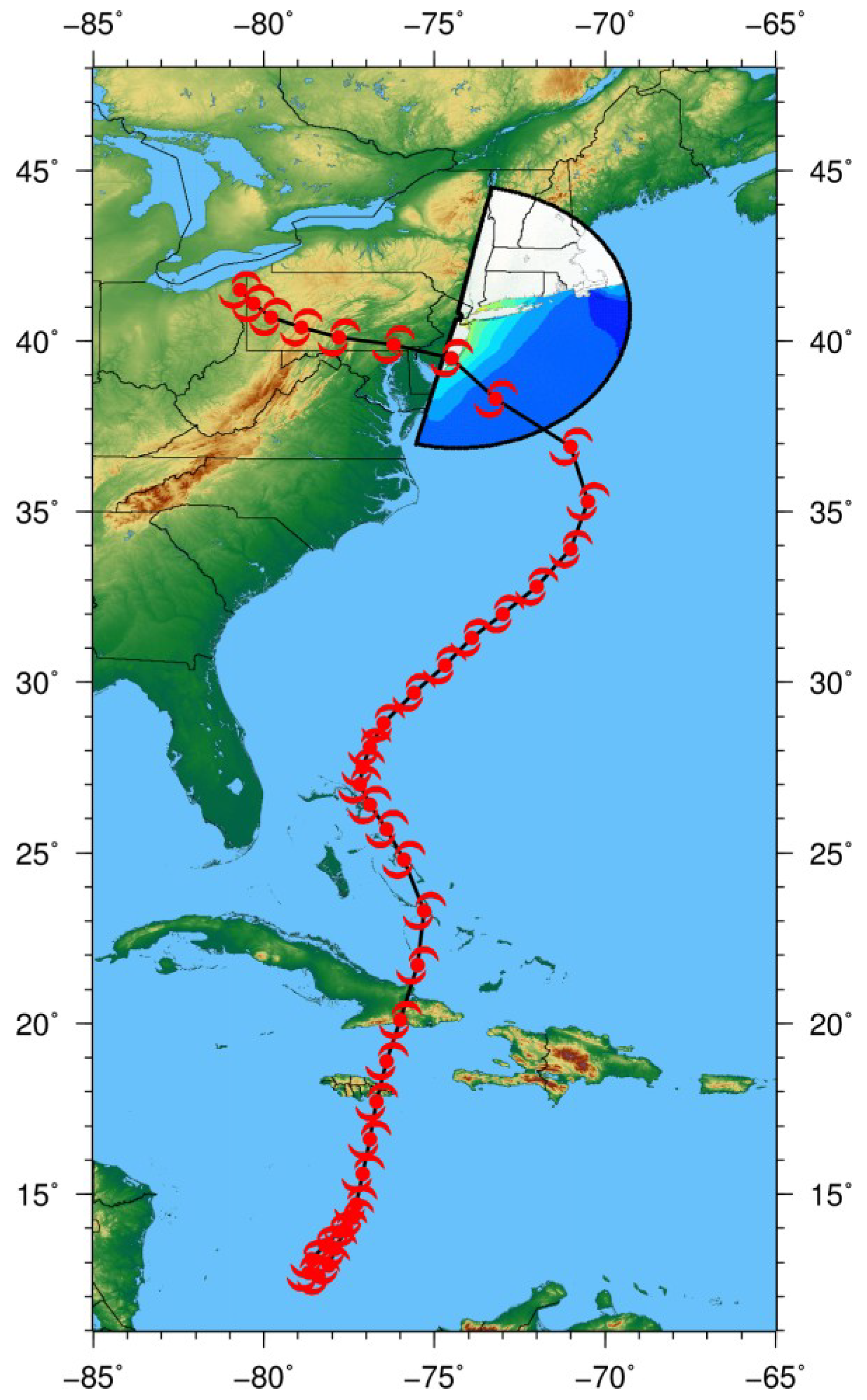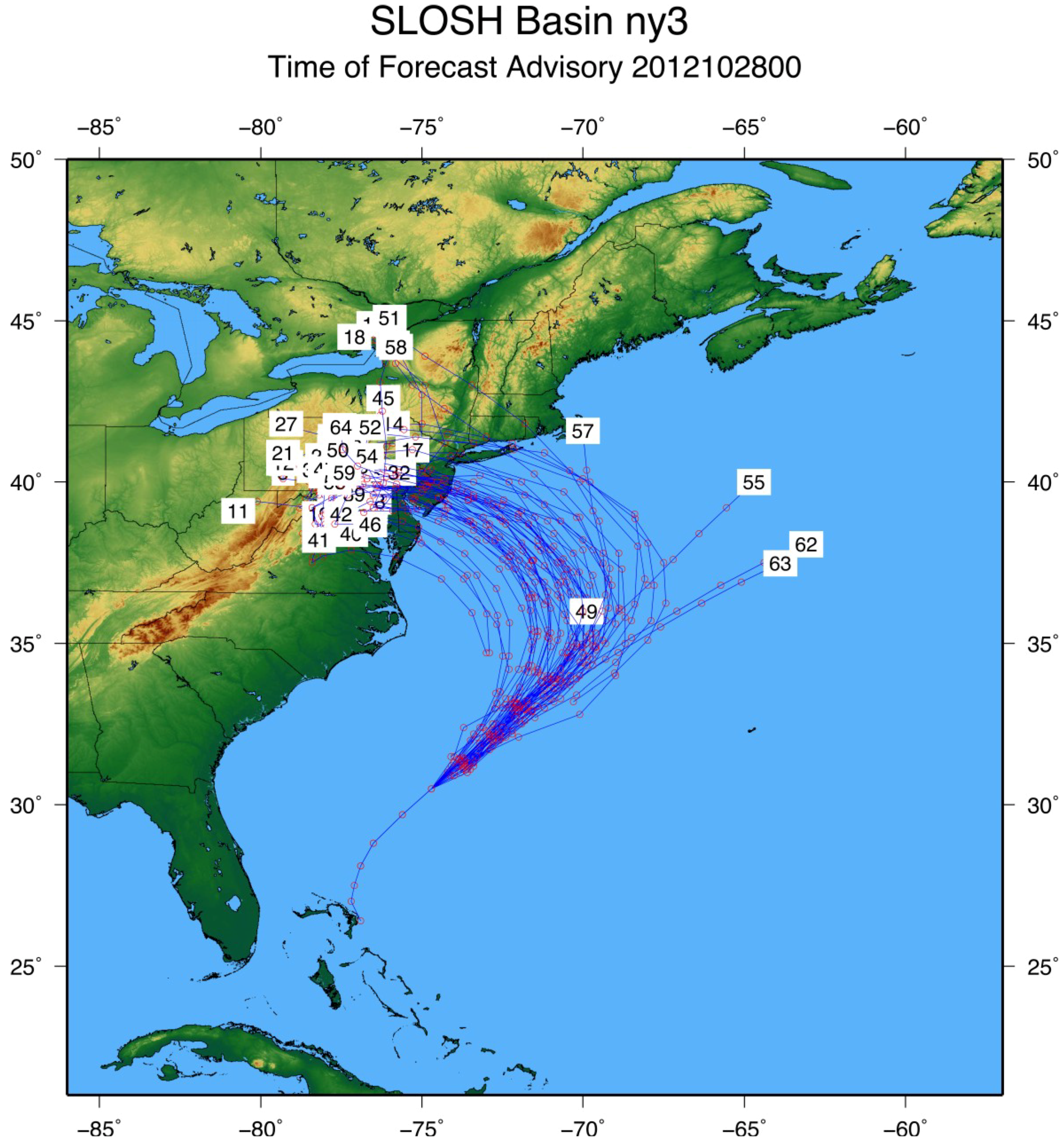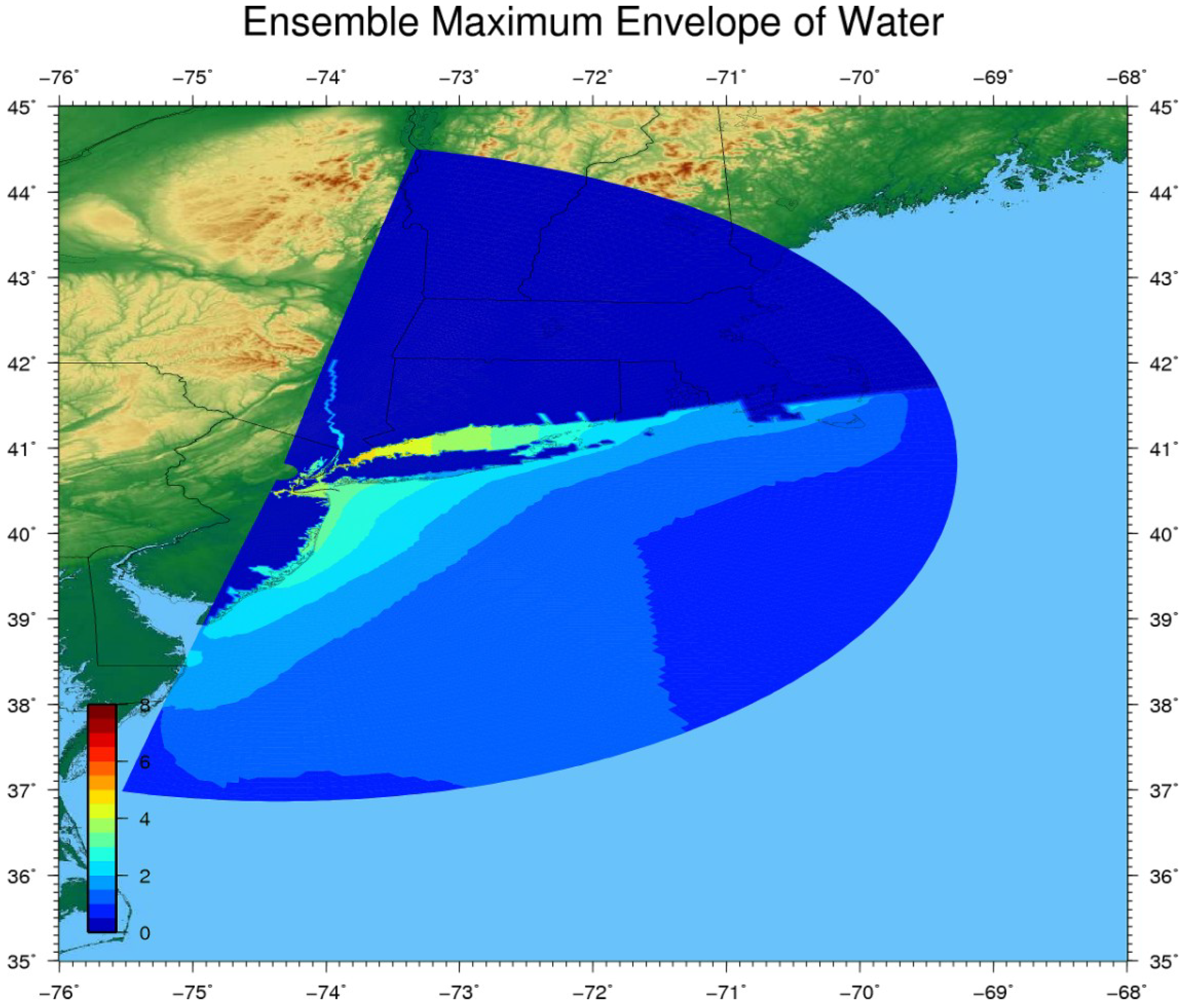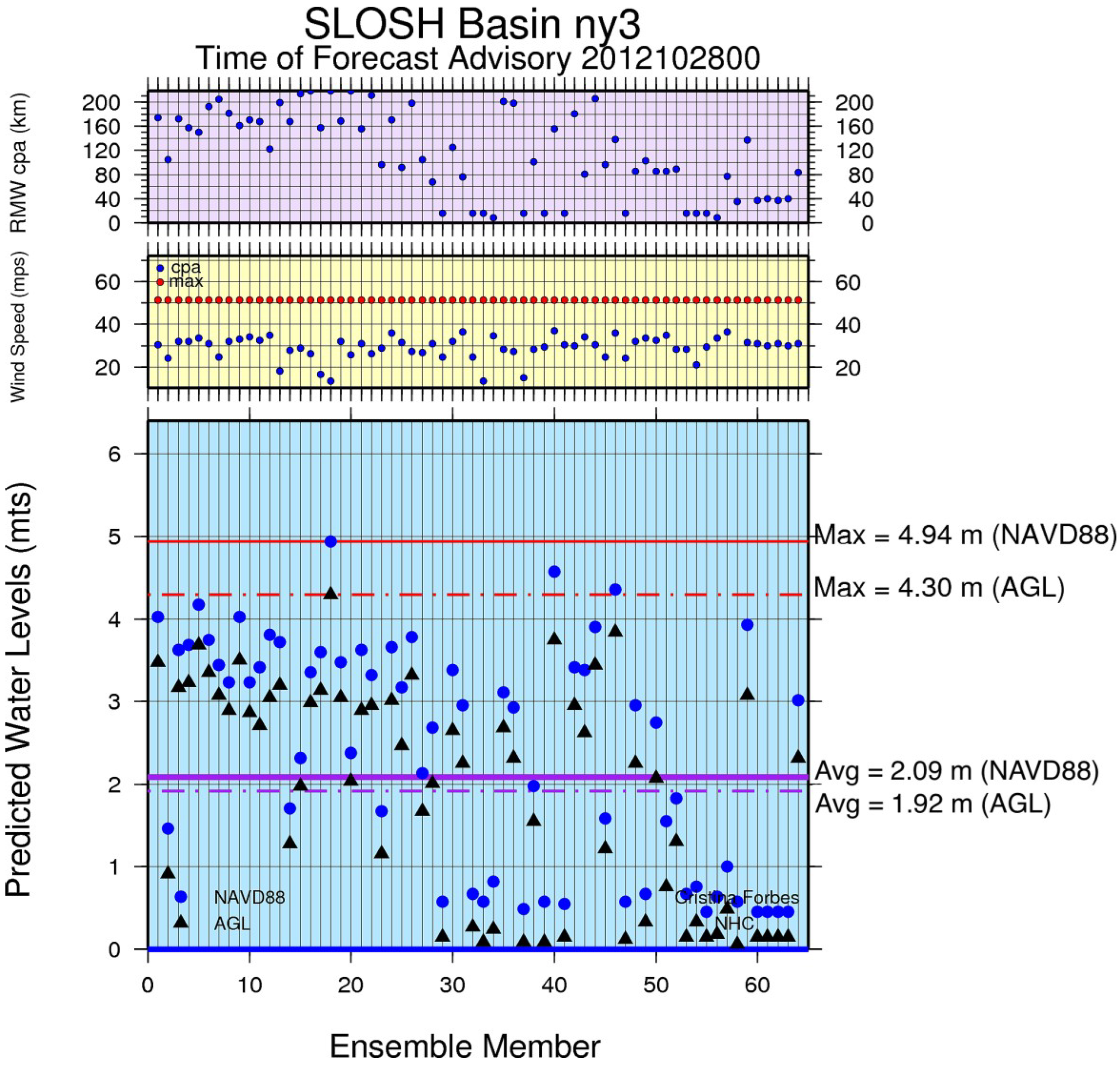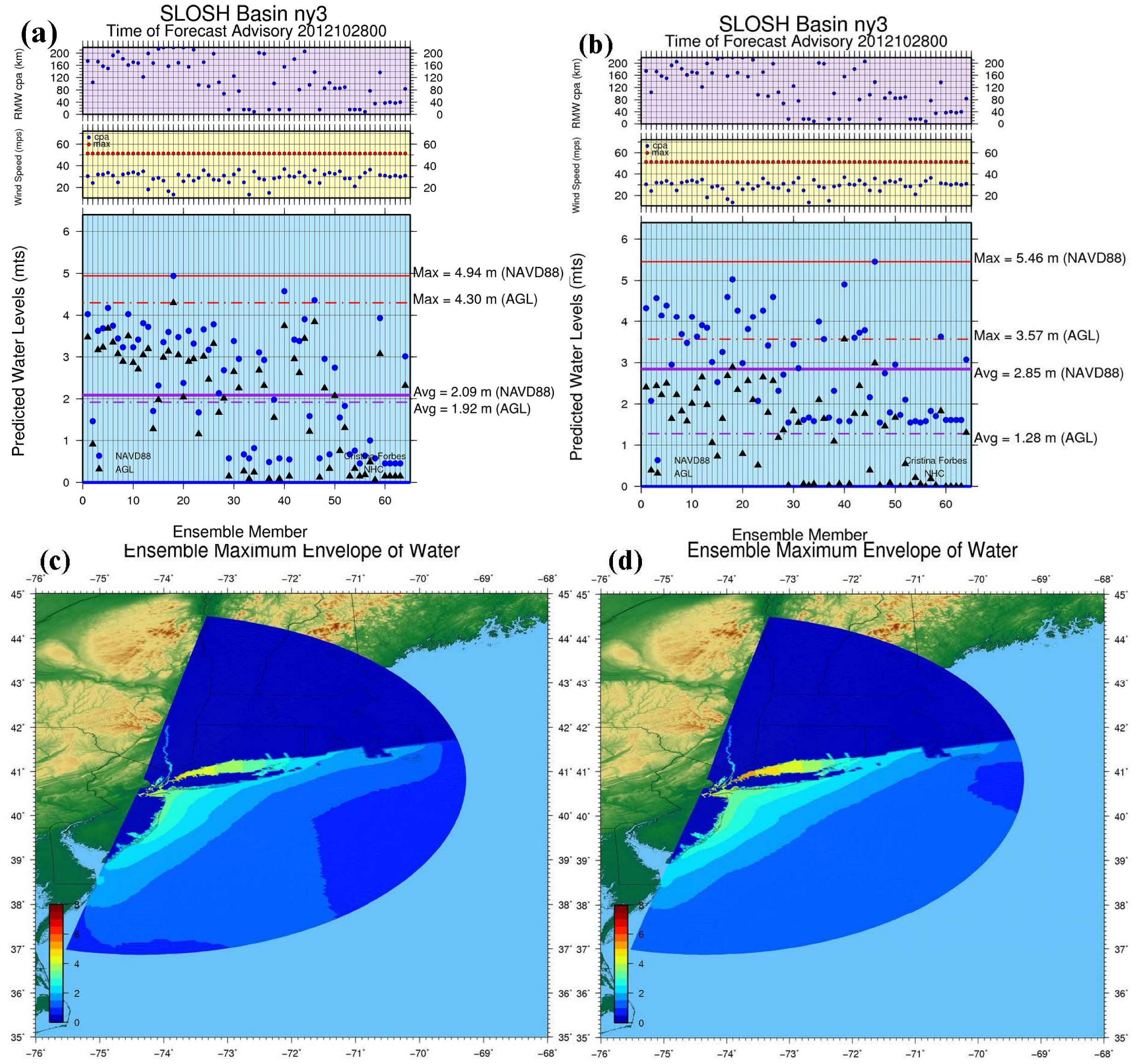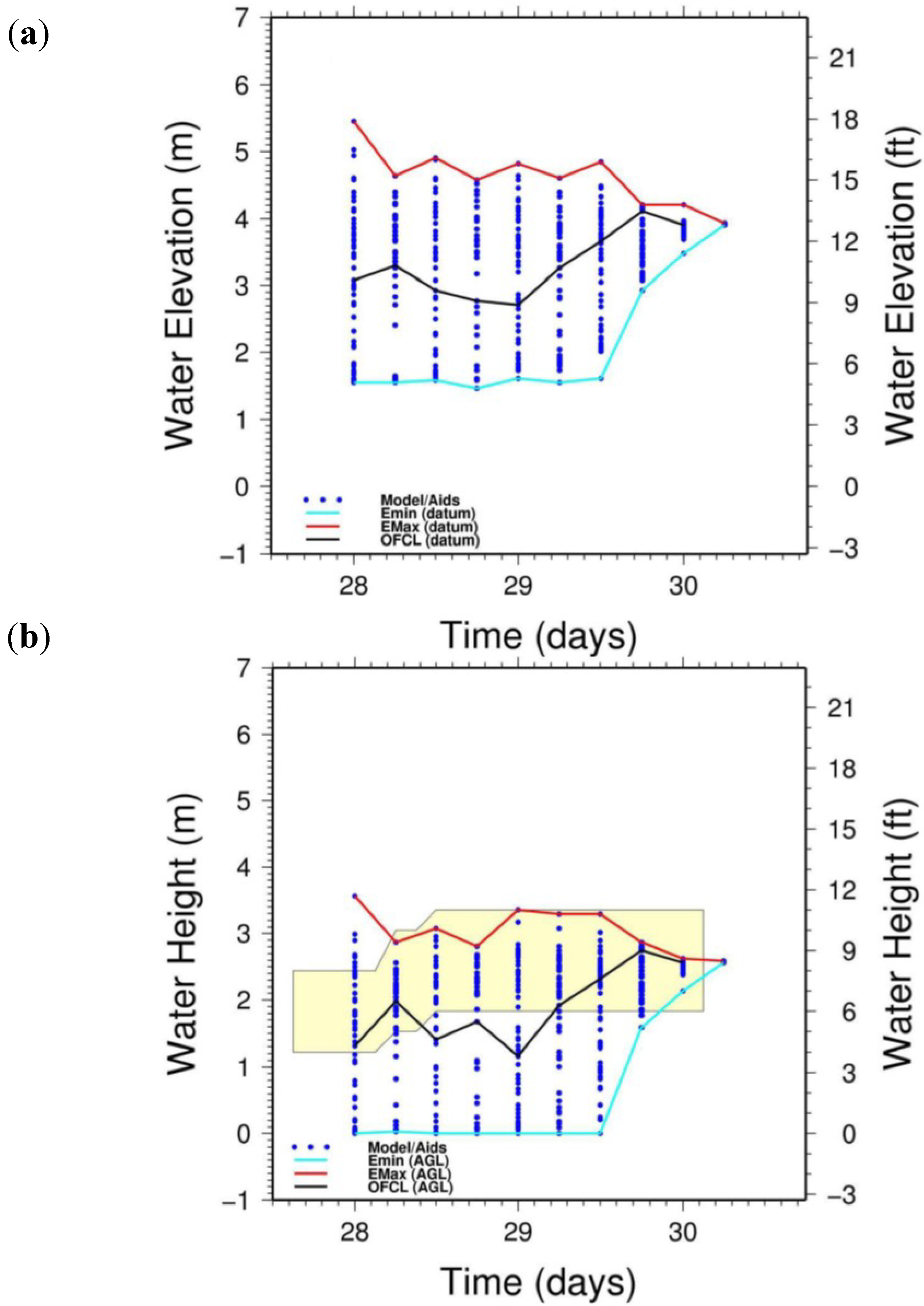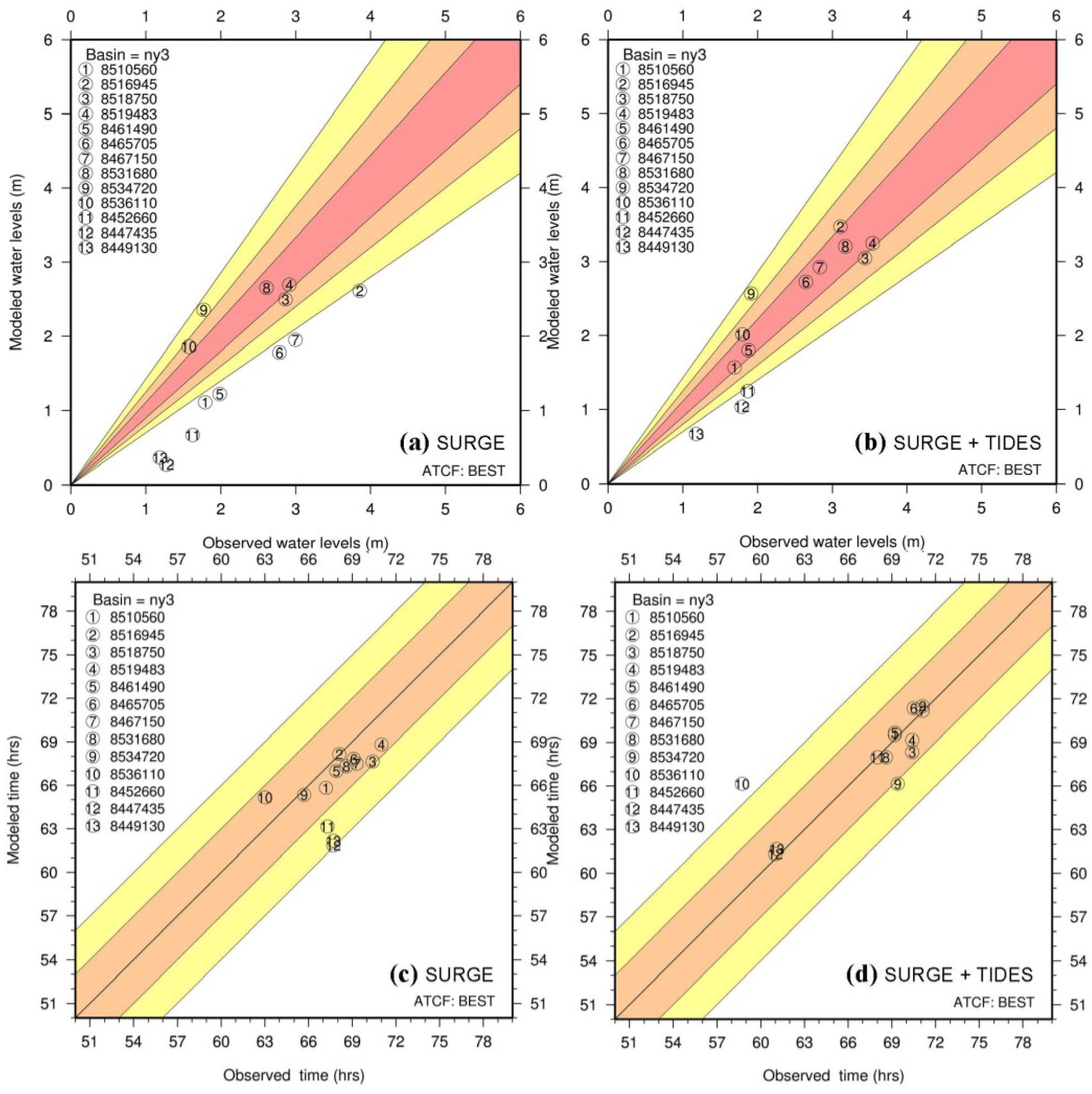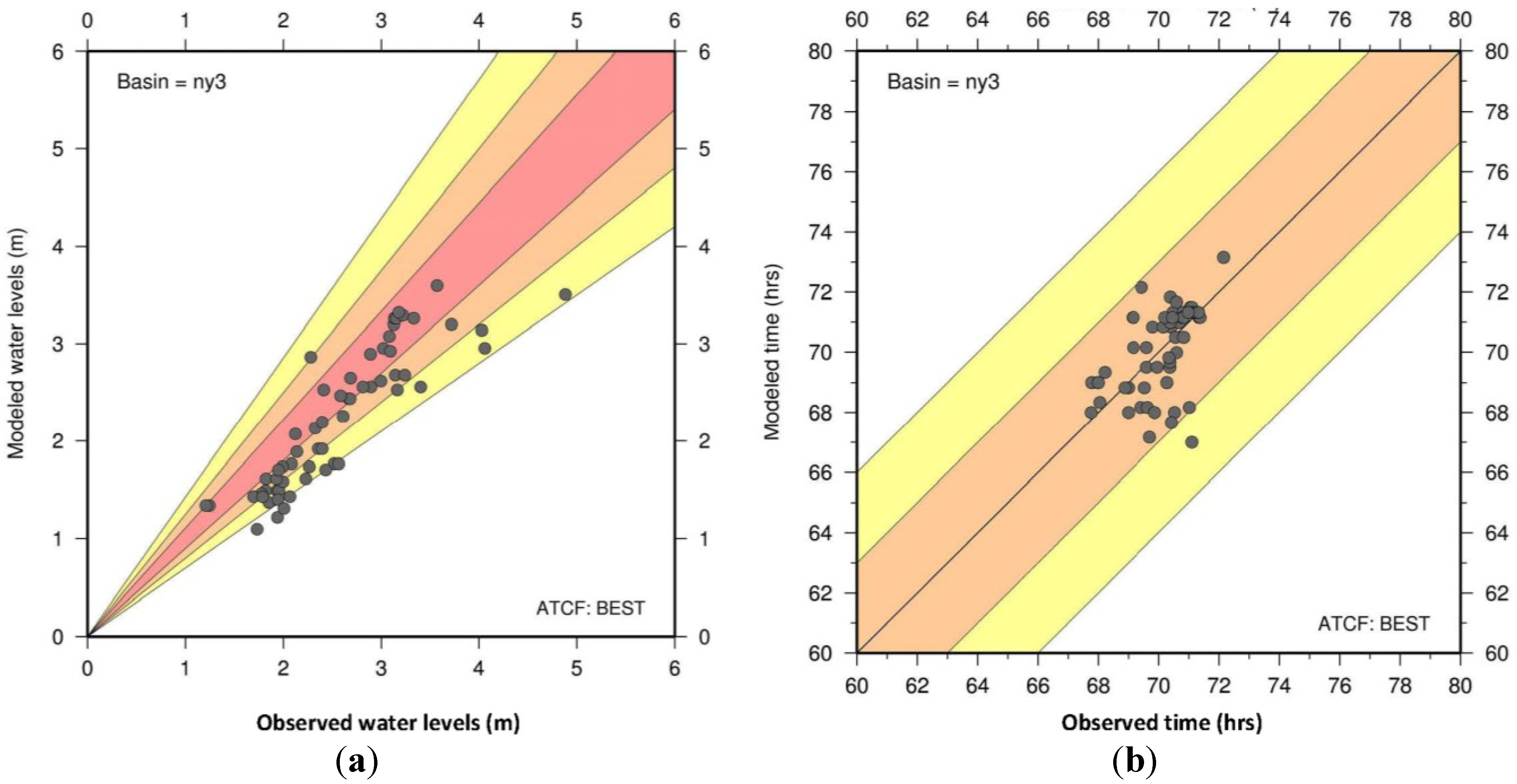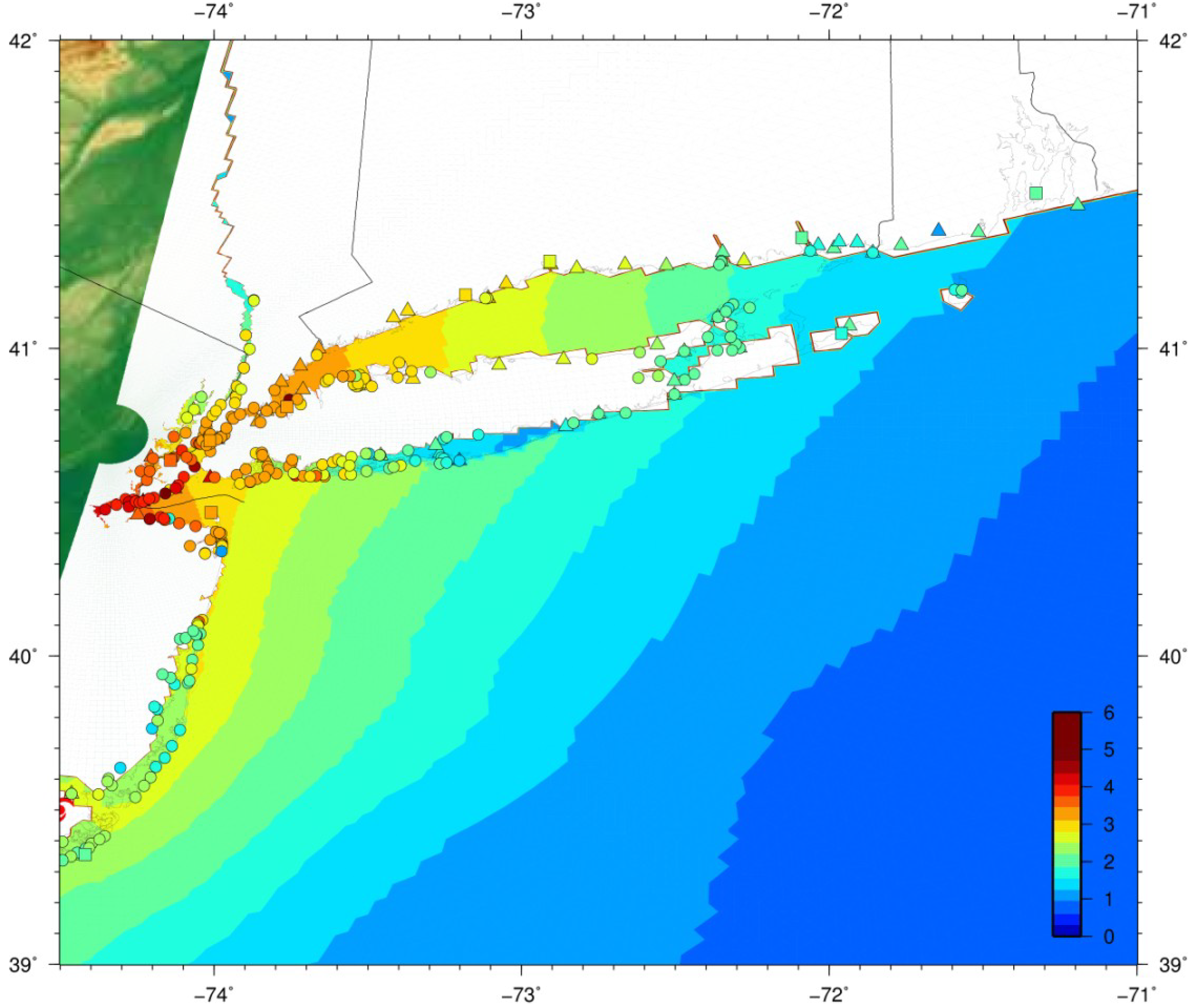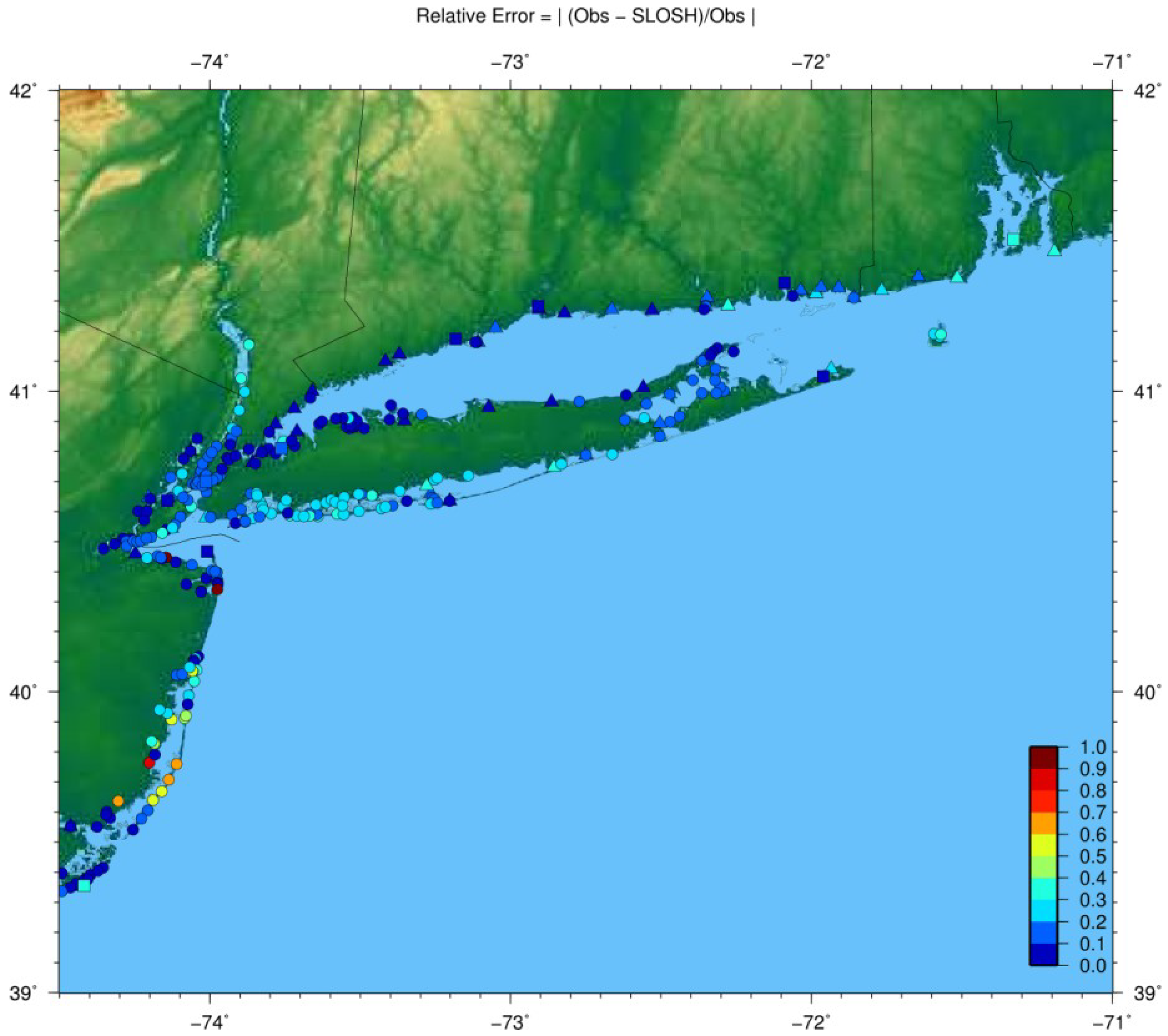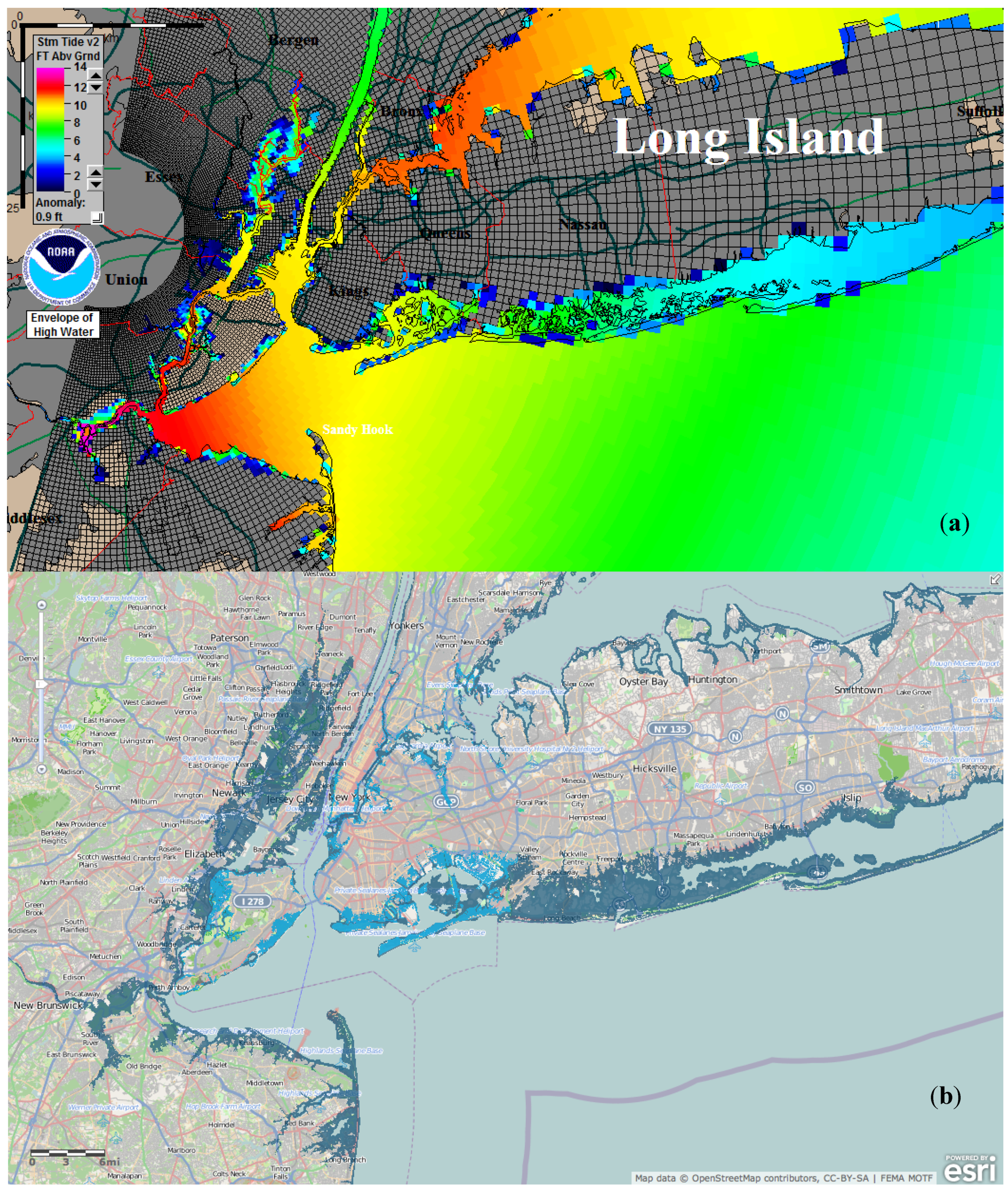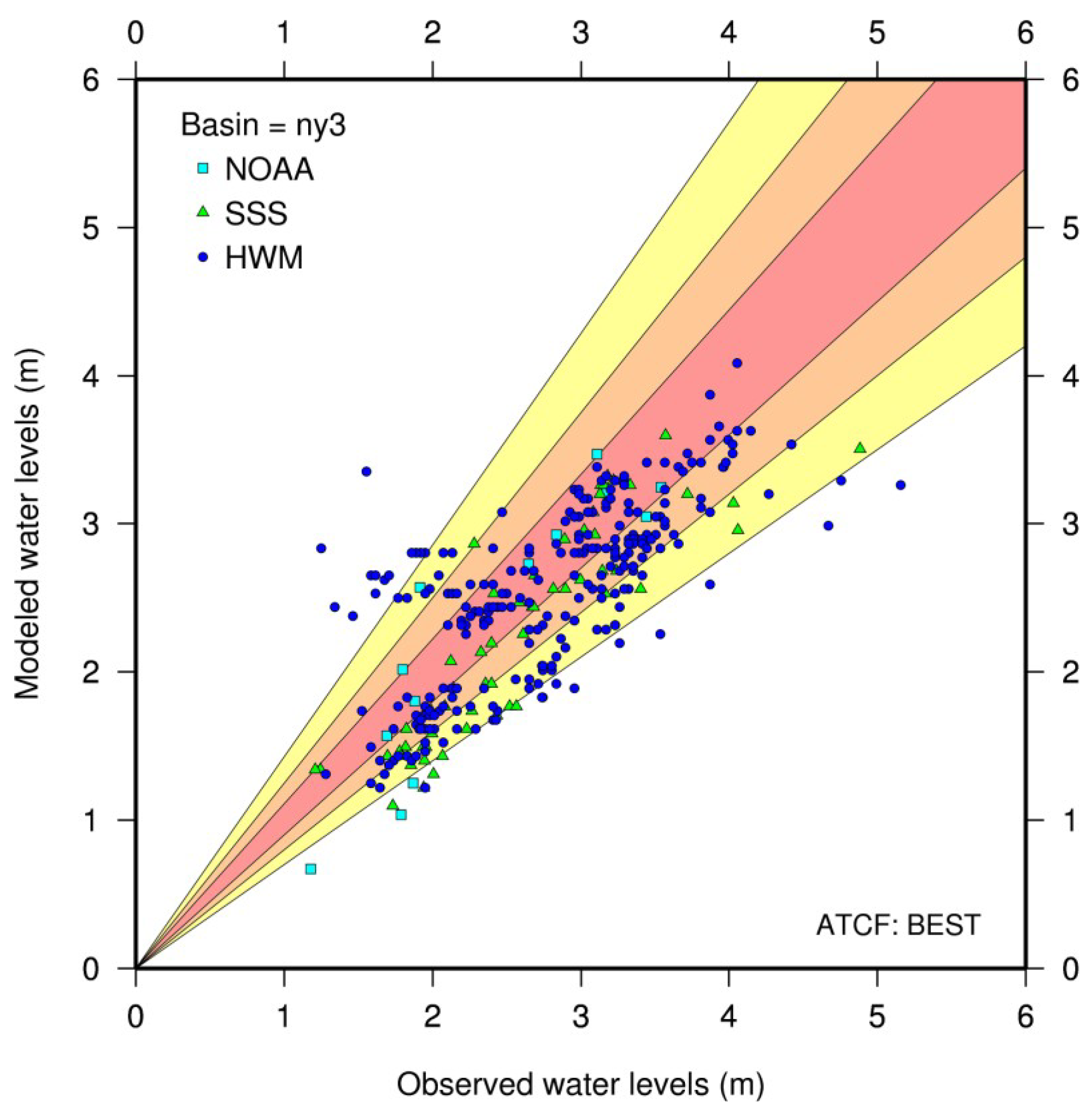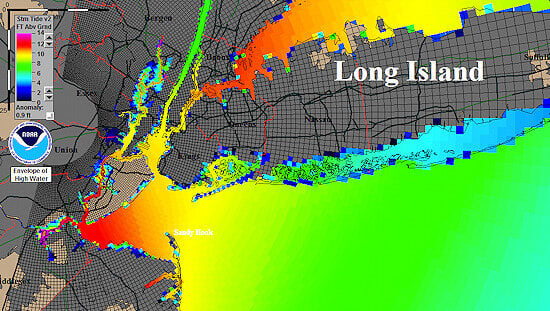1. Introduction
The purpose of this study is to quantify the ability of the National Oceanic and Atmospheric Administration (NOAA)/National Weather Service (NWS) Sea Lakes and Overland Surges from Hurricanes (SLOSH) storm surge prediction model [
1] to replicate the height, timing, evolution and extent of the storm tide that occurred along the US Atlantic coastline during Hurricane (“Superstorm”) Sandy (2012). It will also provide an assessment of the storm surge forecast skill during the storm compared to the model improvements incorporated in the model since. This analysis will serve as a baseline for the evaluation of further enhancements to SLOSH and for comparisons against the results from other modeling systems as NWS moves toward a multi-model ensemble.
Hurricane Sandy [
2] began as a tropical wave off the west coast of Africa on 11 October 2012. It formed in the western Caribbean, south of the island of Jamaica in a region of low wind shear, warm water and a broad area of low pressure on 22 October 2012. The storm made its first landfall near Kingston, Jamaica as a category 1 hurricane on the Saffir-Simpson hurricane wind scale. It reached its peak intensity of 185 kph (115 mph, 100 kts) and made its second landfall in Cuba at 05:25 UTC on 25 October as a category 3 hurricane. The destruction was severe. 17,000 homes were damaged by extensive coastal flooding and high winds. Gusts topped 177 kph (110 mph) in Santiago de Cuba before the anemometer stopped measuring wind speed and 265 kph (165 mph) at Gran Piedra, just west of Guantanamo. Hurricane Sandy then weakened and began expanding in size, reaching a radius of maximum winds (RMW) larger than 185 km (100 nm) over the Bahamas. It re-intensified over the warm Gulf Stream waters as it turned northwest towards the mid-Atlantic states. An anomalous blocking high over the North Atlantic prevented Sandy from moving out to sea, while a baroclinic trough associated with an early winter storm deepened over the southeast US. This accelerated the storm’s forward speed to 37 kph (20 kts) and steered it northwest, where it encountered cold water and transitioned to an extratropical cyclone 83 km (45 nm) southeast of Atlantic City, NJ [
2], 2.5 h prior to its final landfall. It approached the coast as a category 1 hurricane and made landfall at 23:30 UTC Monday 29 October 2012, near Brigantine, NJ (northeast of Atlantic City) as a post-tropical cyclone, with maximum sustained winds of 130 kph (80 mph, 70 kts) and a central pressure of 945 mb. The GOES-13 natural color satellite image in
Figure 1a shows the cold front interacting with Hurricane Sandy approximately one day before landfall. The lowest pressure found was 940 mb (dropsonde estimate) a few hours before landfall in NJ [
2] and a warm front developed in the storm’s northeast quadrant, as seen in the NOAA surface weather chart in
Figure 1b.
Figure 1.
(a) GOES-13 natural color satellite image at 17:45 UTC on 28 October 2012 (courtesy of NASA Earth Observatory); and (b) surface weather chart at 21 UTC 29 October 2012, approximately two and a half hours before landfall (courtesy of the National Oceanic and Atmospheric Administration (NOAA)). Note the interaction of the hurricane with the approaching winter storm, the subsequent drop in mean sea level pressure to 940 mb, and the development of cold and warm fronts during the hybridization process off the coast of New Jersey.
Figure 1.
(a) GOES-13 natural color satellite image at 17:45 UTC on 28 October 2012 (courtesy of NASA Earth Observatory); and (b) surface weather chart at 21 UTC 29 October 2012, approximately two and a half hours before landfall (courtesy of the National Oceanic and Atmospheric Administration (NOAA)). Note the interaction of the hurricane with the approaching winter storm, the subsequent drop in mean sea level pressure to 940 mb, and the development of cold and warm fronts during the hybridization process off the coast of New Jersey.
One of the most dangerous aspects of Hurricane Sandy was its large size, approximately 1150 miles (1850 km) in diameter, based on the extent of the last closed isobar, with a wind field that created a significant storm tide threat to vast areas along the Atlantic coastline and inland. Hurricane Sandy retained its large wind field, large radius of maximum winds, and hybrid characteristics through landfall [
2]. After Hurricane Sandy made landfall in NJ, its sustained winds increased as an effect of the winter storm approaching from the west. The combination of both Hurricane Sandy and the winter storm, timed with the full-moon high tide on the night of 29 October, worsened the storm-tide flooding along the NJ, NY and CT coastlines and caused significant flooding far inland along the Delaware and Hudson Rivers [
3]. Hurricane Sandy caused 147 direct deaths (286 total) and damage of
$68 billion dollars. It is the second-costliest Atlantic hurricane on record.
The storm surge above astronomical tide produced by Hurricane Sandy reached its highest observed levels of 3.86 m (12.65 ft) at Kings Point at the western end of Long Island Sound. A storm surge of 2.91 m (9.56 ft) was recorded along the northern side of Staten Island at Bergen Point West Reach. At The Battery, on the southern tip of Manhattan, values of 2.87 m (9.40 ft) were measured and at Sandy Hook, NJ the gauge failed when the surge crested to 2.61 m (8.57 ft). In Montauk, at the east tip of Long Island, Atlantic City, NJ and Cape May, NJ storm surge values peaked at 1.80 m (5.89 ft), 1.77 m (5.82) and 1.57 m (5.16 ft), respectively.
According to a recent National Hurricane Center (NHC) technical memorandum [
4], inundation is defined as the total water level that occurs on normally dry ground as a result of the storm tide. It is expressed in terms of height of water, in feet, above ground level (AGL). NHC’s official forecasts provide storm surge-induced flooding information in terms of inundation (feet of water above ground level). The tidal datum MHHW (Mean Higher High Water) is considered the best possible approximation of the threshold at which inundation can begin to occur since at the coast, areas higher than MHHW are typically dry most of the time.
The highest recorded
total water levels, which occurred within half an hour of high tide in the Staten Island and Manhattan areas, reached a record 4.28 m (14.06 ft) above Mean Lower Low Water (MLLW), 2.74 m (8.99 ft) above MHHW at The Battery, NY; a record 4.36 m (14.31 ft) above MLLW, 1.98 m (6.51 ft) above MHHW at King’s Point, and 4.44 m (14.58 ft) above MLLW, 2.76 m (9.06 ft) above MHHW at Bergen Point West Reach. At The Battery, the
storm tide (the combination of storm surge and astronomical tide [
4]) crested 1.39 m (4.55 ft) higher than the water that occurred during Hurricane Irene (2011) [
2]. Storm tide records were broken in Sandy Hook, NJ with 4.03 m (13.23 ft) MLLW, 2.44 m (8.01 ft) MHHW and at Philadelphia, PA with 3.24 m (10.62 ft) MLLW, 1.2 m (3.93 ft) MHHW 8 h after landfall. The tide gauge at Sandy Hook failed before the peak water levels were reached.
Table 1 summarizes the maximum total, tide (referenced to various vertical datums) and surge water levels reached at three NOAA stations at the coast: The Battery, Bergen Point and Kings Point. At The Battery total water levels crested at the same time as the surge, even though the highest tides arrived half an hour earlier. At Bergen Point the maximum surge arrived half an hour after the highest total water level, while at Kings Point the maximum surge arrived two hours before the highest total water level.
A buoy at the entrance of New York Harbor (Station 44065), 15 nm southeast of Breezy Point, NY, measured a record significant wave height (SWH, the highest one-third of all wave heights measured during a 20-min sampling period) of 9.86 m (32.5 ft) at 00:50 UTC on 30 October and an atmospheric pressure of 958 hPa, while buoys in Central (44039) and Western (44040) Long Island Sound recorded SWHs of 2.2 m and 2.1 m, respectively. Buoy (44009) at Delaware Bay, 48 km (26 nm) SE of Cape May, NJ, USA, reached a SWH of 7.38 m. At more than 300 km (190 miles) away from the point of landfall at Block Island, RI (44097), SWHs reached 9.48 m. Even as far away as 450 km (280 miles) at Buoy 44008, located 54 nm SE of Nantucket Shoals, a SWH of 10.97 m was registered.
Table 1.
Maximum total, tide (referenced to various vertical datums) and surge water levels reached at three NOAA tide gauge stations at the coast: The Battery, Bergen Point and Kings Point, NY (see
Figure 2 for station locations).
Table 1.
Maximum total, tide (referenced to various vertical datums) and surge water levels reached at three NOAA tide gauge stations at the coast: The Battery, Bergen Point and Kings Point, NY (see
Figure 2 for station locations).
| Station (ID) | Time/Vertical Datum | Maximum Total Water Level m (ft) | Maximum Tide m (ft) | Maximum Surge Above Astronomical Tide m (ft) |
|---|
| The Battery, NY (8518750) | Time | 30 October 2012 | 30 October 2012 | 30 October 2012 |
| 01:24 UTC | 00:54 UTC | 01:24 UTC |
| MHHW | 2.74 (8.999) | −0.10 (−0.315) | 2.87
(9.40) |
| NAVD88 | 3.44 (11.280) | 0.60 (1.965) |
| MSL | 3.50 (11.486) | 0.66 (2.172) |
| MLW | 4.22 (13.848) | 1.38 (4.534) |
| MLLW | 4.28 (14.055) | 1.44 (4.741) |
| Bergen Point, NY (8519483) | Time | 30 October 2012 | 30 October 2012 | 30 October 2012 |
| 01:24 UTC | 00:54 UTC | 02:00 UTC |
| MHHW | 2.76 (9.065) | −0.80 (−0.259) | 2.91
(9.56) |
| NAVD88 * | 3.54 (11.623) | 0.70 (2.299) |
| MSL | 3.60 (11.801) | 0.75 (2.477) |
| MLW | 4.38 (14.367) | 1.54 (5.042) |
| MLLW | 4.44 (14.577) | 1.60 (5.252) |
| Kings Point, NY (8516945) | Time | 30 October 2012 | 30 October 2012 | 30 October 2012 |
| 02:06 UTC | 04:24 UTC | 23:06 UTC |
| MHHW | 1.98 (6.509) | −0.07 (−0.224) | 3.86 (12.65) |
| NAVD88 † | 3.11 (10.201) | 1.06 (3.468) |
| MSL | 3.18 (10.423) | 1.12 (3.690) |
| MLW | 4.28 (14.035) | 2.22 (7.302) |
| MLLW | 4.36 (14.311) | 2.31 (7.578) |
High Water Marks measured by USGS sensors recorded the highest water level inland, a value of 2.71 m (8.9 ft) AGL, at the US Coast Guard Station in Sandy Hook, NJ, followed by 2.44 m (8.0 ft) AGL at the South Street Seaport near the Brooklyn Bridge and 2.41 m (7.9 ft) AGL in the Oakwood neighborhood of Staten Island and on the south side of Raritan Bay. Values between 1 and 2 m occurred at Maspeth, Fire Island, Battery Park, Oak Beach-Captree, Rockaways, Lower Manhattan, Freeport, Hempstead, Long Island, Nassau County, Brooklyn, Wading River in Town of Riverhead, Inwood, near John F. Kennedy Airport (JFK), Bronx, Throgs Neck area. Runways and tarmacs at JFK and La Guardia were inundated as well.
Figure 2.
Map of NOAA tide gauge station locations.
Figure 2.
Map of NOAA tide gauge station locations.
These various measurements depict the difficulty in assessing the storm surge threat because water level values might be referenced to different vertical datums or the quoted water surface elevations might represent only partial components of the total water level (e.g., tide or surge). It is easy to see how the public could become confused by this plethora of information and why it is crucial to communicate the storm surge threat clearly to the public to minimize the loss of life. Therefore, in addition to producing operational storm surge forecasts and issuing public advisories, the National Hurricane Center (NHC) has worked extensively with social scientists to craft graphics and text that convey the potential dangers of storm surge effectively [
6].
Operational storm surge forecasts during the storm and post-storm hindcast simulations of Hurricane Sandy were run by forecasters in NHC’s Storm Surge Unit using the NWS Sea, Lake, and Overland Surges from Hurricanes (SLOSH) model. This manuscript describes the operational forecasts of Hurricane Sandy run in the SLOSH ny3 basin (
Figure 3), the improvements to the surge forecasting system implemented during 2013, and how the storm would have been predicted had the enhanced system been available in 2012.
Hindcast simulations of Hurricane Sandy were run for analysis and verification. Comparisons of observed water levels at NOAA tide gauge stations, by USGS temporary storm surge sensors (SSS) and high water marks (HWM) were compared with the numerically simulated water levels to assess model performance.
Figure 3.
Hurricane Sandy track and the storm tide (m) simulated by the Sea, Lake, and Overland Surges from Hurricanes (SLOSH) numerical storm surge prediction model in the ny3 basin.
Figure 3.
Hurricane Sandy track and the storm tide (m) simulated by the Sea, Lake, and Overland Surges from Hurricanes (SLOSH) numerical storm surge prediction model in the ny3 basin.
2. Model
SLOSH [
1] is a numerical coastal ocean model used by the National Weather Service to run: (1) real-time operational; (2) hypothetical (for evacuation planning); (3) historical (for validation purposes); (4) probabilistic [
7]; and (5) extratropical storm surge prediction simulations.
It is an extremely computationally efficient, 2-D explicit, finite-difference model, formulated on a semi-staggered Arakawa B-grid [
8]. The horizontal transport equations are solved through the application of the Navier-Stokes momentum equations for incompressible and turbulent flow. The SLOSH model transport equations were derived by Platzman [
9], in which the dissipation is determined solely by an eddy viscosity coefficient. A bottom slip coefficient was included by Jelesnianski [
10]. The governing equations are integrated over the entire depth of the water column. At every time step, the horizontal transports are solved from the pressure, Coriolis and frictional forces. These transports generate an updated level of surge at every model grid point. SLOSH includes a wetting-and-drying algorithm to predict inland inundation.
A simplified parametric wind model is embedded in the SLOSH model. The input parameters of the wind model consist of the storm track (latitude and longitude of the center’s location), radius of maximum winds and the difference between the environmental and the central pressures (pressure drop) of the storm. The wind-driven forcing is incorporated into SLOSH as wind stress.
SLOSH grids have different shapes (hyperbolic, elliptical or polar) that can be customized for specific coastline geometries, with higher resolution near the coast and grid cells that telescope outward concentrically to lower resolution offshore. There are 37 operational SLOSH basins that cover the east coast of the US, the Gulf of Mexico, the Bahamas, Puerto Rico and the Virgin Islands. The bathymetry and topography in the model grid cells are derived from National Elevation Dataset (NED) digital elevation models (DEMs) from the U.S. Geological Survey (USGS), the NOAA National Geophysical Data Center (NGDC) Tsunami inundation DEMs, and Light Detection and Ranging (LIDAR) data from the US Army Corps of Engineers (USACE) or from state and local sources, if available, and the bathymetry from NGDC 3 arc-second Coastal Relief Model. All the bathymetric/topographic data must be referenced to a single vertical datum and averaged to obtain the depth/elevation of each individual SLOSH cell. The land cover classifications are derived from the USGS 30 m spatial resolution National Land Cover Database (NLCD). SLOSH basins include subgrid-scale features that allow simulation of the flow through barriers, gaps, passes, overtopping of barriers, roads, and levees.
An automated, event-triggered, storm surge prediction system, AutoSurge [
11], was developed at NHC in 2010 to accelerate forecaster workflows by eliminating labor-intensive tasks, computing storm parameters with greater accuracy and preventing human input error. The system runs the SLOSH model; the input is determined objectively and consistently for all operational simulations. AutoSurge automatically generates a vast array of products from the SLOSH model output to provide internal guidance to the Storm Surge Specialists.
3. Forecasts
As soon as a tropical disturbance with the potential of developing into a tropical cyclone in the subsequent 48-h is identified in the Atlantic Ocean, Caribbean Sea, or the Gulf of Mexico, AutoSurge begins generating storm surge forecast simulations using the SLOSH model. The system alerts the Storm Surge Specialists at NHC, sending guidance products via e-mail, and the results are available on an internal web site, both in tabular and graphical format. Forecasts are run using storm track information that includes the latitude and longitude of the storm’s center, intensity (maximum sustained 1-min wind speed), pressure drop and radius of maximum winds from NHC’s Best Track operational data and parameters from all of the model information available to the Hurricane Specialists at NHC. The SLOSH parametric wind model is used to ensure that the parameters in the SLOSH wind formulation are consistent with those in the model guidance,
i.e., the resulting wind speed in the SLOSH wind model is in accordance to the NHC’s Best Track and the model guidance intensity, in a manner similar to other storm surge forecast systems [
12,
13].
Graphics of the ensemble maximum envelope of water, model track spread, individual ensemble member maximum water levels, wind intensity, the radius of maximum winds, and forecast trends are generated to depict the expected range of the storm surge forecasts to account for variability in the atmospheric forcing.
AutoSurge was run in surge-only mode during the 2012 hurricane season. More than 1000 AutoSurge numerical simulations were run during Hurricane Sandy using the Best Track and the internal NHC model guidance used to create the official track (OFCL). The ensembles are derived from the suite of statistical, dynamical and consensus track and intensity models that NHC’s Hurricane Specialists use to create their forecasts (National Weather Service Global Forecast System and Global Ensemble Forecast System, Hurricane Weather Research and Forecasting Model, Statistical Hurricane Intensity Prediction Scheme, Climatology and Persistence model, Logistic Growth Equation Model, Limited Area Barotropic Model, Navy Operational Global Prediction System, Canadian Global Environmental Multiscale Model, United Kingdom Met Office model, University of Wisconsin non-hydrostatic modeling system, European Center for Medium-range Weather Forecasting global model, Florida State University Super-ensemble, Geophysical Fluid Dynamics Laboratory model). This meteorological forcing was used to drive the SLOSH storm surge prediction model over multiple SLOSH basins, from Puerto Rico to the Bahamas and along the U. S. East Coast. Results for the ny3 basin will be described and the model output graphics will be shown in this manuscript. These ensemble simulations are run in conjunction with the probabilistic P-Surge modeling system [
7] developed at NOAA/Meteorological Development Laboratory (MDL), which runs an ensemble of storm surge simulations using historical error statistics of the wind parameters to generate the forecast tracks.
Enhancements made to AutoSurge in 2013 include:
- (1)
Simulations with a new version of the tides (V. 2);
- (2)
Model results relative to both the NAVD88 (North American Vertical Datum of 1988) datum and above ground level;
- (3)
Mini-MEOW (Maximum Envelope Of Water) simulations (a handful of ensembles created by permutations of the OFCL track);
- (4)
Ensemble maximum water level ranges and trends; and
- (5)
Calculations of inundation area.
The new version of SLOSH + Tides (V. 2) incorporates the tides dynamically at every time step and at every SLOSH model grid point [
14]. The location-dependent amplitudes and phases of 37 tidal constituents (selected to be consistent with NOAA/NOS station data) at all locations in the SLOSH grid [
15] used are: M2, S2, N2, K1, M4, O1, M6, MK3, S4, MN4, NU2, S6, MU2, 2N2, OO1, LAM2, S1, M1, J1, MM, SSA, SA, MSF, MF, RHO, Q1, T2, R2, 2Q1, P1, 2SM2, M3, L2, 2MK3, K2, M8, MS4 (for definitions of the harmonic constituents see
Table 2 and the glossary at [
16]).
The harmonic constituents used in the SLOSH + Tides code had recently been extracted from the new, updated experimental EC2013 ADCIRC tidal database. This database employs high-resolution NOAA VDatum meshes (coastal resolution down to 14 m) along the Atlantic and Gulf Coasts of the United States, Puerto Rico and US Virgin Islands, an updated offshore bathymetry using the latest global sources, namely, Space Shuttle Radar Topography Mission SRTM30_PLUS V8.0 from the Scripps Institution of Oceanography and ETOPO1 global relief model from NOAA [
17] and open boundary forcing with the latest global tidal models (TPXO 7.2 OSU Tidal Inversion Software, and later on from the FES 2004 Global Tidal Atlas and the newly released FES2012 model) [
18].
Table 2.
Harmonic tidal constituents used in SLOSH. Each constituent represents a periodic variation in the relative positions of the earth, moon and sun.
Table 2.
Harmonic tidal constituents used in SLOSH. Each constituent represents a periodic variation in the relative positions of the earth, moon and sun.
| Harmonic Constituent Number | Name | Speed (Deg Per Hour) | Description |
|---|
| 1 | M2 | 28.9841042 | Principal lunar semidiurnal constituent |
| 2 | S2 | 30.0 | Principal solar semidiurnal constituent |
| 3 | N2 | 28.4397295 | Larger lunar elliptic semidiurnal constituent |
| 4 | K1 | 15.0410686 | Lunar diurnal constituent |
| 5 | M4 | 57.9682084 | Shallow water overtides of principal lunar constituent |
| 6 | O1 | 13.9430356 | Lunar diurnal constituent |
| 7 | M6 | 86.9523127 | Shallow water overtides of principal lunar constituent |
| 8 | MK3 | 44.0251729 | Shallow water terdiurnal |
| 9 | S4 | 60.0 | Shallow water overtides of principal solar constituent |
| 10 | MN4 | 57.4238337 | Shallow water quarter diurnal constituent |
| 11 | NU2 | 28.5125831 | Larger lunar evectional constituent |
| 12 | S6 | 90.0 | Shallow water overtides of principal solar constituent |
| 13 | MU2 | 27.9682084 | Variational constituent |
| 14 | 2N2 | 27.8953548 | Lunar elliptical semidiurnal second-order constituent |
| 15 | OO1 | 16.1391017 | Lunar diurnal |
| 16 | LAM2 | 29.4556253 | Smaller lunar evectional constituent |
| 17 | S1 | 15.0 | Solar diurnal constituent |
| 18 | M1 | 14.4966939 | Smaller lunar elliptic diurnal constituent |
| 19 | J1 | 15.5854433 | Smaller lunar elliptic diurnal constituent |
| 20 | MM | 0.5443747 | Lunar monthly constituent |
| 21 | SSA | 0.0821373 | Solar semiannual constituent |
| 22 | SA | 0.0410686 | Solar annual constituent |
| 23 | MSF | 1.0158958 | Lunisolar synodic fortnightly constituent |
| 24 | MF | 1.0980331 | Lunisolar fortnightly constituent |
| 25 | RHO | 13.4715145 | Larger lunar evectional diurnal constituent |
| 26 | Q1 | 13.3986609 | Larger lunar elliptic diurnal constituent |
| 27 | T2 | 29.9589333 | Larger solar elliptic constituent |
| 28 | R2 | 30.0410667 | Smaller solar elliptic constituent |
| 29 | 2Q1 | 12.8542862 | Larger elliptic diurnal |
| 30 | P1 | 14.9589314 | Solar diurnal constituent |
| 31 | 2SM2 | 31.0158958 | Shallow water semidiurnal constituent |
| 32 | M3 | 43.4761563 | Lunar terdiurnal constituent |
| 33 | L2 | 29.5284789 | Smaller lunar elliptic semidiurnal constituent |
| 34 | 2MK3 | 42.9271398 | Shallow water terdiurnal constituent |
| 35 | K2 | 30.0821373 | Lunisolar semidiurnal constituent |
| 36 | M8 | 115.9364166 | Shallow water eighth diurnal constituent |
| 37 | MS4 | 58.9841042 | Shallow water quarter diurnal constituent |
AutoSurge incorporated V. 2 of SLOSH + Tides in the forecast system workflow for the 2013 hurricane season. AutoSurge used V. 2.1 of SLOSH + Tides for the ny3 basin, which has a tide-forcing threshold (bathymetric depth of influence) from the deep ocean up to a specified depth. Testing and analysis of various threshold depths for the ny3 basin determined that the optimum setting was 100 ft (30.48 m).
Due to the limited amount of time available to complete the numerical forecasts, the model runtime has to be short to be able to construct the storm surge prediction ensembles. The runtime performance for a typical SLOSH model simulation run over the ny3 basin on a typical desktop PC or Linux workstation is shown in
Table 3.
Table 3.
AutoSurge runtime performance for the SLOSH ny3 basin.
Table 3.
AutoSurge runtime performance for the SLOSH ny3 basin.
| SLOSH Basin | SLOSH Surge-Only | SLOSH Tides + Surge | SLOSH Tides + Surge+ Graphics |
|---|
| ny3 | 1 min 49 s | 3 min 14 s | 4 min |
In the past two years, directed by research, testing and recommendations from social scientists [
6], NHC’s public advisories were modified to include values of inundation above ground level at the peak of high tide so the public would better understand the storm surge threat. An example, Public Advisory 26A, issued for 8:00 PM EDT (00:00 UTC) Sunday 28 October 2012, one day before Hurricane Sandy made landfall in New Jersey, is shown in
Figure 4. Note that the water levels are referenced “above ground” and are considered valid only if the peak surge occurs at the time of high tide.
Figure 4.
The National Hurricane Center’s (NHC) Public Advisory 26A, valid at 8:00 PM EDT (00:00 UTC) on Sunday, 28 October 2012; one day before Hurricane Sandy made landfall. Note that the inundation depths are given in feet above ground level, with the caveat that these values would be reached only if the peak of astronomical tides coincided with the peak of the storm surge.
Figure 4.
The National Hurricane Center’s (NHC) Public Advisory 26A, valid at 8:00 PM EDT (00:00 UTC) on Sunday, 28 October 2012; one day before Hurricane Sandy made landfall. Note that the inundation depths are given in feet above ground level, with the caveat that these values would be reached only if the peak of astronomical tides coincided with the peak of the storm surge.
3.1. Surge Forecast Simulations
SLOSH surge-only simulations (without tides) were run operationally in 2012 for Hurricane Sandy, as described above.
Figure 5 shows an example of the model tracks used by NHC’s Hurricane Specialists as guidance to determine the OFCL track for Hurricane Sandy 48-hours prior to landfall. It depicts a large spread in the model tracks with various intensities, sizes and storm center locations. This guidance is used to run the ensemble SLOSH simulations.
Figure 6 displays the ensemble maximum envelope of water 48-hours prior to landfall with a maximum total water level of 4.94 m (16.2 ft) NAVD88. A summary plot of the ensemble results for the simulations, valid 48 h prior to landfall, is shown in
Figure 7.
Figure 5.
Example of the model tracks used by the Hurricane Specialists at NHC to develop the OFCL forecast track for Hurricane Sandy. It depicts the large spread in the model tracks with various wind intensities, sizes and track locations. This meteorological guidance is used as forcing to run the SLOSH ensemble storm surge simulations. The label inside the white box at the end of each track indicates the ensemble member number that corresponds to the number in the horizontal axis in
Figure 7.
Figure 5.
Example of the model tracks used by the Hurricane Specialists at NHC to develop the OFCL forecast track for Hurricane Sandy. It depicts the large spread in the model tracks with various wind intensities, sizes and track locations. This meteorological guidance is used as forcing to run the SLOSH ensemble storm surge simulations. The label inside the white box at the end of each track indicates the ensemble member number that corresponds to the number in the horizontal axis in
Figure 7.
Figure 6.
Ensemble maximum envelope of water (m) 48 h prior to landfall with a maximum total water level of 4.94 m (16.2 ft) relative to the NAVD88 vertical datum.
Figure 6.
Ensemble maximum envelope of water (m) 48 h prior to landfall with a maximum total water level of 4.94 m (16.2 ft) relative to the NAVD88 vertical datum.
The bottom (blue) panel provides the maximum predicted water levels relative to both NAVD88 (dark blue dots) and AGL (black triangles) for each ensemble member. The solid (dashed) red lines show the maximum water levels in NAVD88 (AGL) and the solid (dashed) purple lines show the average water levels in NAVD88 (AGL) for each ensemble member. The storm surge threat 48 h prior to the storm was 4.94 m (16.2 ft) relative to the NAVD88 datum, a maximum inundation of 4.30 m (14.1 ft, AGL). The NHC OFCL track (last ensemble member) produced a 3 m (10.0 ft) surge (2.3 m (7.6 ft) of inundation), about 1 m higher than the average of all the ensemble members but lower than the ensemble maximum. The middle (yellow) panel shows the maximum wind speeds (red dots) and wind speeds at the closest point of approach (CPA, blue dots) of each model guidance ensemble member.
The maximum wind speed of 51 ms−1 (100 kt) shows in all the models, which occurred when Sandy made landfall in Cuba on October 25. The winds at the closest point of approach (prior to or at landfall) vary from 8 to 37 ms−1 (17 to 72 kts), which indicates the uncertainty in the wind forcing and, therefore, the variability in the storm surge potential. The top (purple) panel indicates the radius of maximum winds at CPA for each model/aid ensemble, which varies from 8 to 218 km (5 to 136 miles, 4 to 118 nm). This also contributes to the unpredictability of the storm surge hazard, even 48 h prior to actual landfall.
Figure 7.
Summary plot of the ensemble results for the simulations of Hurricane Sandy (2012) valid 48 h prior to landfall. The bottom (blue) panel shows the maximum water levels relative to both the NAVD88 vertical datum (dark blue dots) and AGL (black triangles) for each ensemble member. The solid (dashed) red lines show the maximum water levels in NAVD88 (AGL) and the solid (dashed) purple lines show the average water levels in NAVD88 (AGL) for each ensemble member. The middle (yellow) panel shows the maximum wind speed (red dots) and wind speed at the closest point of approach (CPA) (blue dots) of each model guidance ensemble member. The top (purple) panel indicates the radius of maximum winds at CPA for each model/aid ensemble member.
Figure 7.
Summary plot of the ensemble results for the simulations of Hurricane Sandy (2012) valid 48 h prior to landfall. The bottom (blue) panel shows the maximum water levels relative to both the NAVD88 vertical datum (dark blue dots) and AGL (black triangles) for each ensemble member. The solid (dashed) red lines show the maximum water levels in NAVD88 (AGL) and the solid (dashed) purple lines show the average water levels in NAVD88 (AGL) for each ensemble member. The middle (yellow) panel shows the maximum wind speed (red dots) and wind speed at the closest point of approach (CPA) (blue dots) of each model guidance ensemble member. The top (purple) panel indicates the radius of maximum winds at CPA for each model/aid ensemble member.
As the storm evolves in time, the AutoSurge forecast system calculates the trend of maximum water elevation above NAVD88 and the water height above ground level for all the ensemble members at each synoptic time, as shown in
Figure 8a,b. The yellow box depicts the range of water levels issued by NHC in the forecast advisories. The maximum water elevation levels predicted converge to 3.8 m (12.4 ft) relative to the NAVD88 vertical datum or 2.9 m (9.5 ft) of inundation (AGL).
Figure 8.
Trend of (a) maximum water elevation in the entire SLOSH basin relative to the NAVD88 vertical datum, and (b) the water height above ground level (AGL) for all ensemble members in the SLOSH storm surge-only simulations. The time in days (horizontal axis) denotes the initial time (UTC) of the model forecasts. The yellow box depicts the range of water levels issued in real-time by NHC in the forecast advisories.
Figure 8.
Trend of (a) maximum water elevation in the entire SLOSH basin relative to the NAVD88 vertical datum, and (b) the water height above ground level (AGL) for all ensemble members in the SLOSH storm surge-only simulations. The time in days (horizontal axis) denotes the initial time (UTC) of the model forecasts. The yellow box depicts the range of water levels issued in real-time by NHC in the forecast advisories.
3.2. Surge-Plus-Tides Forecast Simulations
If Hurricane Sandy were to be forecast today with the enhancements described earlier, then the SLOSH model simulations would have tides included in the hydrodynamic equations and would depict the total water levels. A comparison of surge
vs. surge-plus-tides simulation results, in the form of an ensemble summary plot, is shown in
Figure 9a,b, respectively.
Depending on the timing of the tides, the water levels of each ensemble member vary accordingly, in some cases higher and other cases lower than the counterpart without tides. In the case of the surge-plus-tides simulations, the water levels AGL are lower since the cells (areas) that would be wetted by the tides alone at any time during the model simulation are not considered inundated in the results. The maximum water level simulated 48 h prior to landfall is 3.6 m (11.7 ft) AGL for surge-plus-tides, while it is 4.3 m (14.1 ft) for surge-only. The maximum water levels in NAVD88 are higher for the surge-plus-tides simulations, with a maximum of 5.46 m (17.9 ft) as opposed to 4.9 m (16.1 ft) for the surge-only simulations.
The ensemble maximum envelope relative to the NAVD88 vertical datum for both predicted surge-only and surge-plus-tides at 00 UTC on 28 October 2012 are shown in
Figure 9c,d. Clearly, higher values are predicted by the surge-plus-tides ensemble than the surge-only ensemble, as highlighted by the east-west gradient across the Long Island Sound.
Figure 9.
Summary plot of the ensemble results for the simulations of Hurricane Sandy (2012) valid 48 h prior to landfall: (a) for surge and (b) for surge + tides. Ensemble maximum envelope of water for (c) surge and (d) surge + tides 48 h prior to landfall with maximum total water levels of 4.94 m and 5.46 m, respectively (relative to the NAVD88 vertical datum).
Figure 9.
Summary plot of the ensemble results for the simulations of Hurricane Sandy (2012) valid 48 h prior to landfall: (a) for surge and (b) for surge + tides. Ensemble maximum envelope of water for (c) surge and (d) surge + tides 48 h prior to landfall with maximum total water levels of 4.94 m and 5.46 m, respectively (relative to the NAVD88 vertical datum).
The forecast trends of the surge-plus-tides simulations are shown in
Figure 10. The water level values converge to 3.9 m (12.9 ft) relative to NAVD88, or 2.6 m (8.5 ft) AGL. The light yellow polygon delineates the range of water levels issued in real-time by NHC in its forecast advisories, which encompasses the maximum inundation actually recorded during this storm event of 2.71 m (8.9 ft) AGL.
Figure 10.
Trend of (a) maximum water elevation relative to the NAVD88 vertical datum and (b) the water height above ground level (AGL), for all the ensemble members for the surge + tides simulations. The light yellow polygon delineates the range of water levels issued in real-time by NHC in its forecast advisories, which encompasses the maximum inundation actually recorded during this storm event.
Figure 10.
Trend of (a) maximum water elevation relative to the NAVD88 vertical datum and (b) the water height above ground level (AGL), for all the ensemble members for the surge + tides simulations. The light yellow polygon delineates the range of water levels issued in real-time by NHC in its forecast advisories, which encompasses the maximum inundation actually recorded during this storm event.
5. Conclusions
The verification analyses conducted in this study show that the NWS SLOSH storm surge prediction model is able to simulate the height, timing, evolution and extent of the water that was driven ashore by Hurricane Sandy (2012) with a high degree of fidelity. Upgrades to the numerical model in 2013, including the incorporation of astronomical tides with 37 harmonic constituents, have increased its hindcast accuracy and will enable forecasters to better predict the timing and extent of the total water level and inundation.
In addition, the model’s extreme computational efficiency enables it to run large, automated ensembles of predictions in real-time to account for the high variability in atmospheric forcing that can occur in tropical cyclone forecasts, which makes the guidance designed to alert the public and prevent the loss of life more robust and reliable.
Quantitative comparisons (
Figure 19, summary provided in
Table 12) of SLOSH simulation results against water surface peak elevations measured at all 13 NOAA tide gauge stations, by 60 storm surge sensors deployed by the USGS prior to the storm, and from 268 HWMs collected by USGS—a total of 341 observations—reveal that the SLOSH model-simulated water levels at more than one-third (34%) of the data measurement locations have less than 10% error (dark orange cone), while 71% (89%) have less than 20% (30%) error (orange and yellow cones, respectively). The RMS error between the observed and modeled peak water levels is 0.47 m (1.5 ft) (
Table 13).
Figure 19.
Comparison of water levels (m) at all NOAA tidal gauges, USGS storm surge sensors (SSS) and High Water Marks (HWM) vs. SLOSH model-simulated maximum water levels (m). Water surface elevation errors at most locations are within the 10%–20% range (dark orange cone).
Figure 19.
Comparison of water levels (m) at all NOAA tidal gauges, USGS storm surge sensors (SSS) and High Water Marks (HWM) vs. SLOSH model-simulated maximum water levels (m). Water surface elevation errors at most locations are within the 10%–20% range (dark orange cone).
Table 12.
Partition of relative error between observed and SLOSH-simulated maximum water elevation for all measurements: NOAA tide gauge stations and USGS storm surge sensors (SSS) and high water marks (HWM), cumulative (Cum) and individual (Ind).
Table 12.
Partition of relative error between observed and SLOSH-simulated maximum water elevation for all measurements: NOAA tide gauge stations and USGS storm surge sensors (SSS) and high water marks (HWM), cumulative (Cum) and individual (Ind).
| Relative Error | NOAA Cum (Ind) | % | SSS Cum (Ind) | % | HWM Cum (Ind) | % | NOAA + HWM + SSS Cum (Ind) | % |
|---|
| ≤0.10 | 6 (6) | 46 | 21 (21) | 35 | 90 (90) | 34 | 117 (117) | 34 |
| ≤0.20 | 9 (3) | 69 | 40 (19) | 67 | 192 (102) | 72 | 241 (124) | 71 |
| ≤0.30 | 9 (0) | 69 | 55 (15) | 92 | 238 (46) | 89 | 302 (61) | 89 |
| ≤0.40 | 11 (2) | 85 | 60 (5) | 100 | 254 (16) | 95 | 325 (23) | 95 |
| ≤1.00 (>0.40) | 13 (2) | | 60 (0) | | 268 (14) | | 341 (16) | 100 |
| Total | 13 | | 60 | | 268 | | 341 | |
Table 13.
Root mean square error between observed and SLOSH-simulated maximum water elevation for all measurements: NOAA tide gauge stations and USGS storm surge sensors (SSS) and high water marks (HWM), cumulative (Cum) and individual (Ind).
Table 13.
Root mean square error between observed and SLOSH-simulated maximum water elevation for all measurements: NOAA tide gauge stations and USGS storm surge sensors (SSS) and high water marks (HWM), cumulative (Cum) and individual (Ind).
| | NOAA | SSS | HWM | ALL |
|---|
| RMSE | 0.38 m (1.27 ft) | 0.34 m (1.11 ft) | 0.49 m (1.62 ft) | 0.47 m (1.54 ft) |
| Number of Observations | 13 | 60 | 268 | 341 |
The arrival times of the peaks in the water elevation observations at NOAA and USGS SSS stations and their SLOSH-simulated counterparts are in good agreement, as demonstrated by the hydrographs and the statistical calculations (RMSE and correlation) from the time series.
The SLOSH simulations underestimated the surge in some areas far from the point of landfall and far from the center of the SLOSH grid where the resolution is coarser (CT, MA, RI) and in the Raritan Bay where the resolution (2 grid cells) across the East River might not be allowing the water to flow freely into the bay. Many other factors may have contributed to the underestimation of water levels in these locations: grid resolution, basin size, boundary conditions, lack of waves in the simulations, the tidal method, wind field, surface stress, bottom stress,
etc. In this case, the most likely reason for the error is the coarseness of the grid. Previous SLOSH studies [
21] have shown that larger and higher resolution SLOSH grids and different parameterizations of the surface and bottom stresses can improve the accuracy of the storm surge results. Efforts are currently underway to test and validate a coupled SLOSH + SWAN modeling system [
21] that includes surge, tides and waves.
The highly complex structure of Hurricane Sandy presented an operational challenge for the standard tropical version of SLOSH.
Figure 20 shows a comparison between the winds produced by the SLOSH parametric wind model and the real-time multi-platform satellite surface wind analysis at 00 UTC on 30 October 2012 from the NOAA National Environmental Satellite, Data and Information Service (NESDIS), the Cooperative Institute for Research in the Atmosphere (CIRA) Regional and Mesoscale Meteorology Branch (RAMMB) at Colorado State University (CSU) [
22] as Hurricane Sandy made landfall northeast of Atlantic City, NJ. The wind analysis combines information from five different data sources to create a mid-level wind analysis, which is then adjusted to the surface using empirical, radially varying coefficients obtained from reconnaissance aircraft and GPS dropwindsonde data. Despite the simplicity of the SLOSH parametric wind model, the simulated winds are remarkably realistic. There is strong wavenumber 1 asymmetry due to the storm’s forward motion. The 50 kt (25.72 ms
−1) isotachs in panels (a) and (b) are similar in orientation, shape and extent. The SLOSH surface friction simulates a reduction in wind speed of about 10 knots (5.14 ms
−1) over Long Island Sound due to the downwind effects of the Long Island land cover. The wind directions in both panels also compare quite favorably.
Figure 20.
Comparison of wind speeds from (a) the SLOSH parametric wind model and (b) the multi-platform surface wind analysis (courtesy of NOAA/NESDIS and CSU/CIRA/RAMMB). The white square in panel (a) depicts the area where the wind analysis (b) was conducted. Wind speeds are in kts for comparison (1 kt = 0.52 ms−1).
Figure 20.
Comparison of wind speeds from (a) the SLOSH parametric wind model and (b) the multi-platform surface wind analysis (courtesy of NOAA/NESDIS and CSU/CIRA/RAMMB). The white square in panel (a) depicts the area where the wind analysis (b) was conducted. Wind speeds are in kts for comparison (1 kt = 0.52 ms−1).
The basis of this study was to assess a baseline skill level of SLOSH and compare it to its latest improvements demonstrated by the inclusion of tidal constituents in SLOSH. Implementing gridded wind fields, an improved parametric wind model [
12], and a combination thereof are planned upgrades to SLOSH.
The ExtraTropical Storm Surge Model (ETSS), developed by the NOAA/NWS Meteorological Development Laboratory (MDL), is a variation of the NWS SLOSH that runs operationally on NCEP’s central computing system four times daily. The model is forced by real-time output of winds and pressures from the NCEP Global Forecast System (GFS) and produces numerical storm surge guidance for extratropical systems in 6 grids that cover the US East Coast, Gulf of Mexico, West Coast, Gulf of Alaska, Bering Sea and Arctic. This modeling system does not currently include overland flooding or tides. Work is currently underway to combine the ETSS and the newer versions of SLOSH, which include tides and inundation, via nesting from the coarser ETSS grids down to the latest higher resolution SLOSH grids.
An improved version of the Mattocks and Forbes [
12] asymmetric parametric wind model, GWAVA (Gradient Wind Asymmetric Vortex Algorithm), is currently being incorporated into SLOSH. Blending the near-field winds from this more advanced parametric wind model with gridded far-field winds from the GFS or other numerical weather prediction models will potentially improve storm surge prediction by providing more realistic multi-scale wind forcing at the ocean surface and its hydrodynamic response.
The value of future upgrades to the SLOSH model and basin refinements can later be compared to this baseline study. This analysis will also be instrumental in the evaluation of other modeling systems and to assess how they might contribute to operational forecasting as NHC moves toward a multi-model ensemble.
